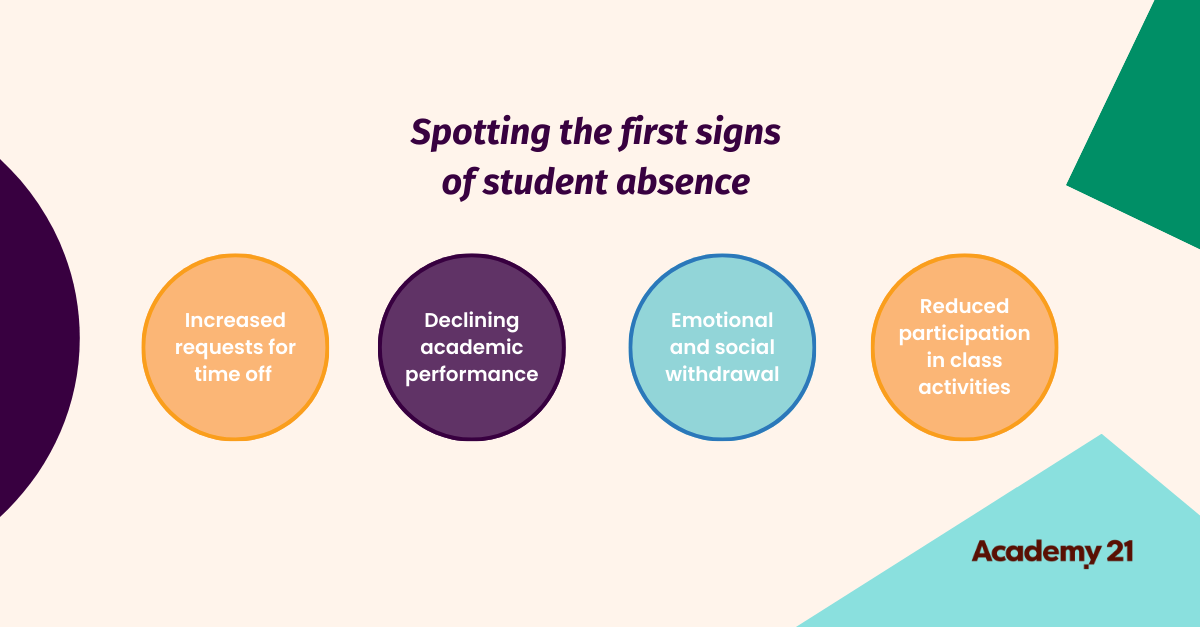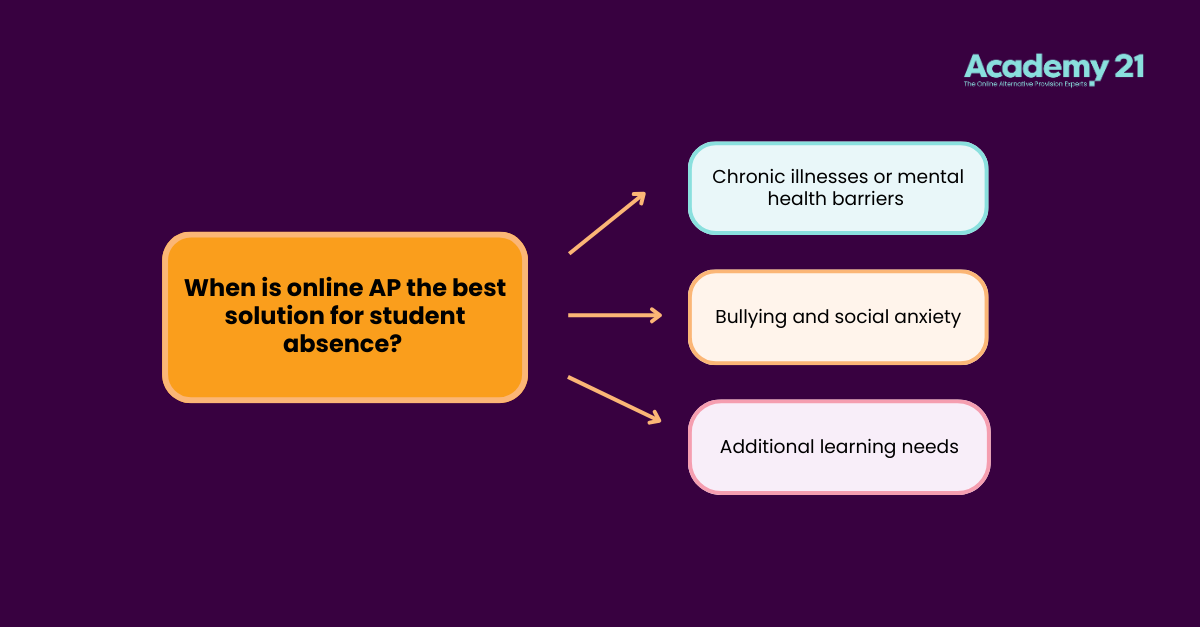Student absence: Early signs and support strategies

Student absence is an ongoing concern for schools across the UK, with far-reaching impacts on academic achievement and student wellbeing. The overall absence rate for the 2024/2025 academic year stands at 6% in the UK, meaning students collectively miss 6 out of every 100 sessions. The percentage is even higher in state-funded special schools, reaching 13.6%. The challenge is not only ensuring students return to school but also understanding why they are absent in the first place and providing appropriate support.
Spotting the first signs of student absence
The first step in addressing student absence is identifying when a student is at risk of falling behind. Early intervention is key to preventing long-term disengagement. So, how can schools spot the first signs of potential absence?
1. Declining academic performance
A drop in usual effort or a sudden decrease in the quality of work often signals that a student is struggling and needs help. This might not immediately be linked to absence, but it’s a flag that something could be going on in the student’s personal life, or they could be facing learning barriers. Students beginning to disengage might not actively tell you about their challenges, so monitoring academic progress regularly is vital, as are the check ins and curiosity that should follow.
2. Reduced participation in class activities
Another sign is a noticeable drop in participation during lessons. If a previously active student starts to avoid contributing to class discussions or group work or even avoids eye contact, this could indicate that they feel demotivated or there is something dominating their thoughts. Withdrawal can be a coping mechanism for students dealing with anxiety or social issues and is thus a useful sign to ensure the right welfare or safeguarding follow ups can take place.
3. Increased requests for time off
If a student starts requesting frequent time off for minor reasons or has unclear reasons for not attending school, it’s essential to investigate further. While some time off can be required, regular absenteeism should be flagged for follow-up, even for short periods. This follow up should be multi-pronged – speaking to the child, the family and looking at the context to unpick the root causes. There are often tweaks that can be made once the cause is known.
4. Emotional and social withdrawal
Changes in behaviour, such as becoming withdrawn or socially isolated, can be linked to absenteeism. Mental health challenges like anxiety or depression are often contributing factors to students avoiding school. Students might struggle to articulate these feelings, so teachers need to notice when a student’s social interactions start to wane.

How to prevent student absence
Once signs of potential absenteeism are identified, schools must act quickly to offer support. Intervening early can prevent issues from escalating. Here are several measures schools can implement to support struggling students:
1. Foster a supportive environment
Creating a safe, welcoming environment is crucial for students at risk of absenteeism. Encourage open communication with students and reassure them that asking for help is okay. Having a mentor or trusted teacher to check in with regularly can give students a sense of security and lessen feelings of isolation.
2. Early intervention programs
Schools should implement early intervention strategies or outsource them from a trusted provider like Academy21, which is flexible to schools’ timelines and can offer support quickly. Early intervention programmes typically involve additional tutoring or working with a school counsellor to address specific issues. For students struggling with specific academic subjects, targeted classes to bring them back up to speed can prevent them from falling further behind and support them with staged reintegration.
3. Connect with families
When you spot the first signs of potential absenteeism, involving parents, guardians, or carers is essential. Maintain open communication with families to keep them informed and establish a shared plan to support the child in school and at home. Having parents involved and working collaboratively with them to develop a strategy for improving attendance is often more effective than addressing the issue in isolation.
4. Flexible learning options
Some students struggle to attend school due to medical conditions, family commitments, or other special circumstances that hinder their ability to attend physical school or follow a more rigid schedule.
Offering flexible learning options, such as live, online lessons or an adapted timetable, can help students who cannot attend full-time at that point. These adaptations allow them to continue their education without the added stress of a traditional school setting.
5. Promote positive attendance habits
Schools should reward good attendance and create a positive culture around it. This can be done through incentives, such as praise for consistently attending or creating school-wide challenges to encourage student participation. Recognising and celebrating improvements, no matter how small, can motivate students to continue attending.
When is online AP the best solution for student absence?
In some cases, despite the best efforts to support students in the traditional school setting, the challenges they face may make regular attendance difficult or even impossible. This is where an online Alternative Provision (AP) can provide a more flexible, tailored solution.
1. Chronic illnesses or mental health barriers
For students who suffer from chronic illnesses or long-term mental health issues, attending a physical school may become too overwhelming or indeed be impossible for a period. Our live online teaching allows these students to study from home, offering a pace, connection and structure that suits their needs. Online learning provides a less stressful environment, allowing students to access their education without the pressures of daily school attendance.
2. Bullying and social anxiety
Bullying and e-bullying can have a significant impact on a student’s willingness to attend school. For students experiencing bullying or those with social anxiety, online learning can be a lifeline. It removes the barriers to education caused by an uncomfortable school environment, allowing the student to continue learning in a safe, supportive space. Students can rebuild their confidence and recover from negative experiences with more focused support, working back to reintegration or transition elsewhere.
3. Additional learning needs
Children with additional learning needs such as ADHD, dyslexia, or autism may need extra support to be successful in the classroom, remain connected to their peers, or to simply meet their needs. Without this some can miss classes more often, which can snowball into persistent absenteeism. Online AP can also benefit students in these cases by providing a calm and focused learning environment that allows them to refocus and thrive. For example, students attend online lessons in small groups, benefiting from regular feedback and input from the teacher in an environment that gives them control. Teachers get to know students and their unique needs so they can target support though technology, be that collaborative platforms, demos or assistive tools to engage and help students organise their thinking and schedules.
Leading alternative provision specialists like Academy21 leverage various innovative learning tools—from class collaboration features to AI-driven learning pathways—to suit students’ learning pace and individual needs. This personalised attention can help students catch up and succeed where they might otherwise fall behind.

Why partner with Academy21
Having partnered with thousands of schools, LAs, and MATs across the UK, Academy21 has unparalleled experience and expertise in preventing and mitigating student absences.
Because we are entirely online, we can seamlessly integrate with existing school schedules. In this hybrid learning model, students blend online lessons with in-person classes and other school activities, and support can scale up or down as needed. Teachers and staff can easily track each student’s progress and monitor attendance and engagement levels through our Mentor Hub.
Plus, our team of expert teachers is skilled in supporting various educational needs. They leverage adaptive teaching approaches and advanced technology like our proprietary InspiredAI tool to ensure that each student feels as comfortable as possible engaging in class, collaborating with others, and addressing any learning gaps. A dedicated SEN team is also on hand to provide extra support when needed.
Our approach delivers proven results. In 2024, 225 students achieved attendance of over 90% with Academy21 and are no longer persistently absent from education. According to our Ofsted report, “Pupils’ attendance improves, and evidence shows that the approaches taken enable pupils to make progress and, in many cases, successfully reintegrate back into their school or other educational placements.’
Overcoming student absence with expert support
Dealing with student absence requires early identification, practical support strategies, and, in some cases, a shift towards more flexible learning environments. To prevent absenteeism from negatively impacting students’ academic progress and wellbeing, spotting the early signs of disengagement and offering personalised, supportive measures is key. If you are looking for an online alternative provider that can adapt to your needs and schedule, contact our team below.



